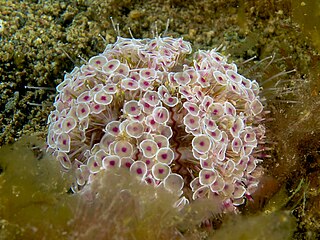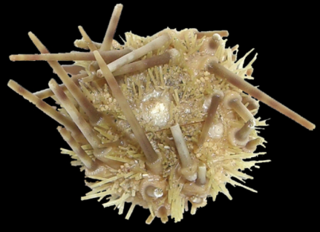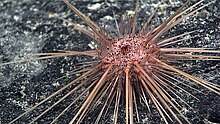
Pedinidae are a family of echinoderms.
Harold St. John was a professor of botany at the University of Hawaiʻi at Mānoa from 1929 to 1958. A prolific specialist in field botany and systematics, he is credited with discovering about 500 new species of Pandanus, along with many other species, especially in the Pacific Islands.

Toxopneustes is a genus of sea urchins from the tropical Indo-Pacific. It contains four species. They are known to possess medically significant venom to humans on their pedicellariae. They are sometimes collectively known as flower urchins, after the most widespread and most commonly encountered species in the genus, the flower urchin. Species included in the genus are the following:

Echinometra is a genus of sea urchins in the family Echinometridae.
Caenopedina alanbakeri is a species of sea urchins of the Family Pedinidae. Their armour is covered with spines. Caenopedina alanbakeri was first scientifically described in 1989 by Rowe.

Caenopedina annulata is a species of sea urchins of the Family Pedinidae. Their armour is covered with spines. Caenopedina annulata was first scientifically described in 1940 by Ole Theodor Jensen Mortensen.
Caenopedina capensis is a species of sea urchins of the Family Pedinidae. Their armour is covered with spines. Caenopedina capensis was first scientifically described in 1923 by Hubert Lyman Clark.
Caenopedina cubensis is a species of sea urchins of the Family Pedinidae. Their armor is covered with spines. Caenopedina cubensis was first scientifically described in 1869 by Alexander Emanuel Agassiz.
Caenopedina depressa is a species of sea urchins of the Family Pedinidae. Their armour is covered with spines. Caenopedina depressa was first scientifically described in 1927 by Koehler.
Caenopedina diomedeae is a species of sea urchins of the Family Pedinidae. Their armour is covered with spines. Caenopedina diomedeae was first scientifically described in 1939 by Ole Theodor Jensen Mortensen.
Caenopedina indica is a species of sea urchins of the Family Pedinidae. Their armour is covered with spines. Caenopedina indica was first scientifically described in 1903 by de Meijere.

Caenopedina mirabilis is a species of sea urchins of the Family Pedinidae. Their armour is covered with spines. Caenopedina mirabilis was first scientifically described in 1885 by Döderlein.
Caenopedina otagoensis is a species of sea urchins of the Family Pedinidae. Their armour is covered with spines. Caenopedina otagoensis was first scientifically described in 1968 by McKnight.
Caenopedina porphyrogigas is a species of sea urchins of the Family Pedinidae. Their armour is covered with spines. Caenopedina porphyrogigas was first scientifically described in 2009 by Anderson.
Caenopedina pulchella is a species of sea urchins of the family Pedinidae. Their armour is covered with spines. Caenopedina pulchella was first scientifically described in 1907 by Alexander Emanuel Agassiz and Hubert Lyman Clark.
Calocidaris micans is a species of sea urchins of the Family Cidaridae. Their armour is covered with spines. Calocidaris micans was first scientifically described in 1903 by Ole Mortensen.

The "raspberry sea urchin", Chondrocidaris brevispina, is a species of sea urchins of the Family Cidaridae. Their armour is covered with short, conical spines.
Cidaris rugosa is a species of sea urchins of the Family Cidaridae. Their armour is covered with spines. Cidaris rugosa was first described in 1907 by Hubert Lyman Clark as Dorocidaris rugosa.

Toxopneustes roseus is a species of sea urchin from the East Pacific. It is sometimes known as the rose flower urchin or the pink flower urchin. Like the related flower urchin, they are venomous.

Toxopneustes maculatus is a rare species of sea urchin found in the Indo-West Pacific.









